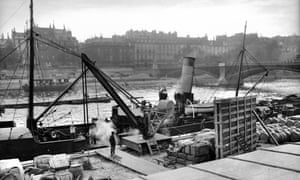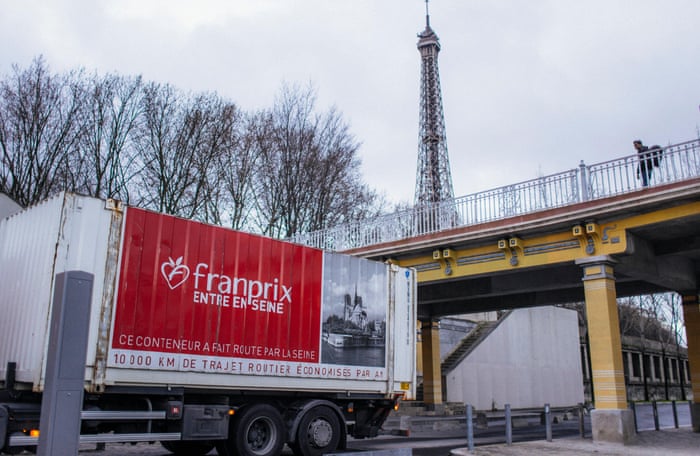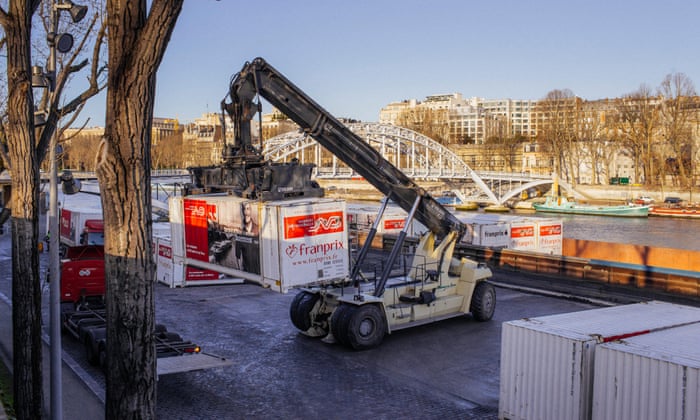Paris's
river revolution: the supermarket that delivers groceries via the Seine
With ever-stricter constraints imposed on road transport in a bid
to make Paris greener, French supermarket Franprix now delivers to 135 of its
stores using river barges. The city has big ideas for the future of the Seine

A container barge transporting
Franprix grocery goods travels along the river Seine to the centre of Paris.
Photograph: Helene Pambrun for the Guardian
Justinien Tribillon
Tuesday
1 March 201602.17 ESTLast modified on Tuesday 1 March 201602.20 EST
On a quiet tributary of
the river Seine, 10km away from Paris’s centre, a barge loaded up with
containers is getting ready to set off from the harbour of Bonneuil-sur-Marne.
The industrial landscape of the harbour owned by the Paris port
authority clashes with the surrounding bucolic scenery: the river Marne was a
popular bathing spot until the 1970s, when swimming was forbidden because of
pollution.
The barge – whose containers are filled with grocery goods ready
to be dispatched to stores and sold – is the centrepiece of an ambitious
project that is slowly putting the river Seine back at the forefront of Paris’s
urban logistics. French grocery retailer Franprix’s pioneering delivery scheme
supplies 135 of its 350 Parisian stores via the Seine, taking as many as 2,600
lorries off the city’s roads each year.
And there is room for more: Franprix alludes to the possibility
of stocking most of its Parisian stores via water. As Paris mayor Anne Hidalgo
openly puts thebreaking up of car culture at the top of
her agenda, are innovative schemes such as “Franprix en Seine” the future of
urban transportation?
“We’re the only grocery retailer worldwide to use river
transport for the final leg of our goods’ journey. We are pioneers,” says
Stéphane Tuot, Franprix’s head of logistics.

Until
the end of the 18th century, two-thirds of the goods consumed or traded in
Paris reached the city via the Seine. Photograph: Roger Viollet/Getty Images
The supermarket chain launched its scheme in 2012, with
significant financial and political support from the European Union, the French
state, the Parisian region and the port of Paris. “The vast majority of our
stores are in Paris and its suburbs, forming a dense network. Our main
warehouse is a few kilometres away from the city centre, close to
Bonneuil-sur-Marne, one of Paris’s main ports. Relying on the Seine seemed
logical.”
The company does not hide the fact that, even with some
financial support from public stakeholders, it is much more expensive to
transport goods via the river instead of the road. Why do it then?

The
Port de la Bourdonnais terminal in the shadow of the Eiffel Tower. Photograph:
Helene Pambrun
“We want to be ahead of the game; there are more and more
constraints on transportation via lorries, and it will only increase in the
future,” says Tuot, mentioning the ban on diesel vehicles from 2020, and the
possibility of a Parisian congestion charge by the end of Mayor Hidalgo’s term
in 2021.
The Seine’s identity is much more complex than the cliche of a
quiet city river cornered by tourism. The touristic aspect of the Seine’s
economy is indeed strong: with 8 million passengers transported each year,
Paris is the busiest inland harbour in the world. But with 20m tonnes of goods
conveyed each year, it is also the second largest in Europefor
merchandise.
After three hours of journey, two locks and 21km of navigation,
Franprix’s barge arrives at the Port de la Bourdonnais, a tiny facility
squeezed between the Eiffel Tower and the Musée du Quai Branly. The harbour offers
two attributes and activities: a pier for bateaux mouches (open
excursion boats) on one hand; on the other, a bijou container terminal used by
the construction industry and Franprix.
Tuot says his company’s scheme is far from having reached its
full capacity: “There is room to have much more merchandise transiting via the
Seine, and we hope to announce new partnerships in the near future. In the long
term, if we’re accompanied by public bodies and the right investments, there’s
room to deliver all of our 350 Parisian stores via the Seine – that’s totally
doable.”
The scheme has already demonstrated its efficiency by taking
lorries of the road: Franprix calculated it saves the equivalent of 300,000km
of road transit, almost 9,000 times the length of Paris’s ring road.
Franprix
supplies 135 of its 350 Parisian stores via the Seine, taking 2,600 lorries off
the city’s roads each year. Photograph: Helene Pambrun for the Guardian
While it remains a drop in an ocean of pollution, the city looks
at such urban logistic solutions with great interest. In her city hall office,
Paris deputy mayor Célia Blauel, in charge of sustainable development and
water, says that the Seine and Paris’s canals are key to their strategy for a
greener and more sustainable Paris. The socialist mayor Bertrand Delanoë
(2001-2014) and his successor have both supported controversial plans to get
rid of the motorways that run along the Seine and give the riverbanks back to pedestrians.
According to Blauel, more will be done to promote leisure and
tourism for the Seine, for instance, an objective to allow Parisians to bathe
in the Seine by 2030. But enhancing the role of the Seine as an infrastructure
will also be crucial. “More cars and lorries is not the solution for Paris, we
need to get rid of that way to navigate the city.”
While schemes such as Franprix en Seine remain
notable exceptions, the role of the river Seine in Paris’s future is about to
benefit from a significant boost. Following strong interest around the urban
design competition “Reinvent Paris” – which saw international
teams of urbanists and architects contending to redevelop 23 sites in Paris –
City Hall confirmed to The Guardian that Mayor Hidalgo will, on 14 March,
announce “Reinvent the Seine”, a similar scheme focusing on 40 sites all along
the river.
According
to Stéphane Tuot, ‘There’s room to deliver all of our 350 Parisian stores via
the Seine – that’s totally doable.’ Photograph: Helene Pambrun for the Guardian
The instigator of Reinvent Paris, Deputy-mayor Jean-Louis
Missika, a sociologist-turned-politician who is serving his third term in
office, believes every global city needs the sea, adding that, “The Greater
Paris needs to rely on the Seine to design a ‘blue framework’ from Paris to Le
Havre.”
This idea has gained momentum since Paris-based architect
Antoine Grumbach proposed in 2009 to design a Greater Paris with the Seine as
its spine, on a Paris-Rouen-Le Havre axis. With this grand design, Grumbach,
who in 1996 also won a competition to design a
(never-built) “garden bridge” over the Thames in London, proposed to transform
Paris into a port city like New York or Shanghai.

“The competition Reinvent the Seine, developed hand in hand with
the cities of Rouen and Le Havre, will be about casting a new light on to the
Seine,” Missika explains. “It will be about enabling architects, urbanists and
citizens to dream, and have crazy ideas about the Seine and its future.”
Yet as Paris rediscovers the charms and assets of the Seine, the
scenic river risks a clash of competing activities — on the one hand,
riverbanks reclaimed for pedestrians, floating structures such as swimming poolsand hotels, and the popular Paris Plage, which transforms the Seine into
an urban beach every summer; on the other, the rise of river-based urban
logistics and the building of new facilities, along with ever-increasing
passenger traffic.
 “One thing is certain: today the Seine is Paris’s most
attractive public space,” Missika says. “That is why we need to get urbanists
and architects thinking about how to anticipate and resolve these conflicts.”
“One thing is certain: today the Seine is Paris’s most
attractive public space,” Missika says. “That is why we need to get urbanists
and architects thinking about how to anticipate and resolve these conflicts.”
Today, however, Franprix’s lonely barge with its emptied
containers is quietly sailing back to the port of Bonneuil-sur-Marne, while
traffic jams continue to build up on the Seine’s soon-to-be-pedestrianised
riverbanks.
No comments:
Post a Comment